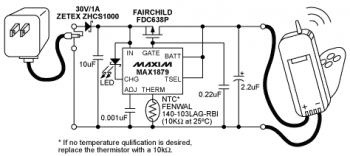Above diagram is the circuit of Lithium-ion (Li-ion) battery charger which built based single chip MAX1879. This is the simple and low cost battery charger for single-cell Li+ battery that does not dissipate power (no heat.
The MAX1879, in conjunction with the AC linear transformer adapter and a PMOS FET, allows safe and fast charging of a single Li+ cell. The MAX1879 is not only an inductorless required solution, but also the lowest power dissipated solution among single-cell Li+ battery chargers.
The MAX1879 with a current limited linear wall adapter can produce the most economic and efficient solution for the single-cell Li+ off-line cradle charger, with virtually no power loss on the PMOS FET. It can be easily designed for handheld devices or battery packs without excessive power dissipation and heat problems.
Read detailed explanation about this Lithium-ion (Li-ion) battery charger circuit at maxim-ic.com
About MAX1879:
The MAX1879 single-cell lithium-ion (Li+) battery charger utilizes an efficient pulse-charging architecture to minimize power dissipation in portable devices. This architecture combines the efficiency of switch-mode chargers with the low cost and simplicity of linear chargers. This simple device, in conjunction with a current-limited wall cube and a PMOS transistor, allows safe and fast charging of a single Li+ cell.
MAX1879 Features:
- Low Electronic Component Count, No Inductor
- Simple Design Minimizes Heat
- 0.75% Accurate Battery Regulation
- 1.5µA (max) Battery Current Drain with Wall Cube Removed
- Restart Charging at 4.0V
- Battery-Full Indicator
- Safely Precharges Near-Dead Cells
- Automatic Power-Down when Power Source is Removed
- Continuous Overvoltage and Overtemperature Protection
- Charges 1 Cell from as Low as 4.5V
- Pin-Compatible Upgrade to MAX1679

Comments